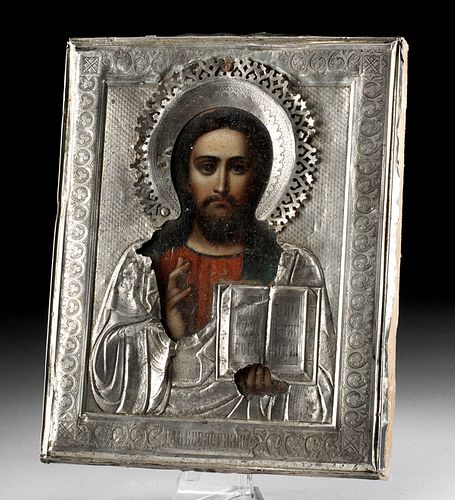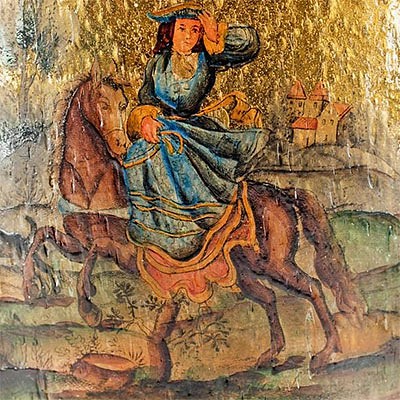19th C. Russian Icon Pantocrator Christ / Silver Oklad
Lot 44c
About Seller
Artemis Fine Arts
686 S Taylor Ave, Ste 106
Louisville, CO 80027
United States
Selling antiquities, ancient and ethnographic art online since 1993, Artemis Gallery specializes in Classical Antiquities (Egyptian, Greek, Roman, Near Eastern), Asian, Pre-Columbian, African / Tribal / Oceanographic art. Our extensive inventory includes pottery, stone, metal, wood, glass and textil...Read more
Categories
Estimate:
$1,800 - $2,500
Absentee vs Live bid
Two ways to bid:
- Leave a max absentee bid and the platform will bid on your behalf up to your maximum bid during the live auction.
- Bid live during the auction and your bids will be submitted real-time to the auctioneer.
Bid Increments
| Price | Bid Increment |
|---|---|
| $0 | $25 |
| $300 | $50 |
| $1,000 | $100 |
| $2,000 | $250 |
| $5,000 | $500 |
| $10,000 | $1,000 |
| $20,000 | $2,500 |
| $50,000 | $5,000 |
| $100,000 | $10,000 |
| $200,000 | $20,000 |
About Auction
By Artemis Fine Arts
May 13, 2021
Set Reminder
2021-05-13 12:00:00
2021-05-13 12:00:00
America/New_York
Bidsquare
Bidsquare : Spring Art Auction | Fine, Folk, Fun
https://www.bidsquare.com/auctions/artemis-gallery/spring-art-auction-fine-folk-fun-6949
Featuring visual treats from around the world, and back in time to present day - fine art, folk art, and fun artsy objects. Paintings. Sculptures. Textiles. More. Convenient in-house shipping. Artemis Fine Arts info@artemisgallery.com
Featuring visual treats from around the world, and back in time to present day - fine art, folk art, and fun artsy objects. Paintings. Sculptures. Textiles. More. Convenient in-house shipping. Artemis Fine Arts info@artemisgallery.com
- Lot Description
Eastern Europe, Russia, ca. late 19th century CE. Hand painted in egg tempera on wood with an 88% silver oklad cover (also oclad or riza) delineated in repousse and chased with finely delineated details, a Christ Pantocrator icon presenting Christ delivering a blessing with his right hand and holding an open book of Gospels with his left; His halo beautifully chased with a cloud-like band followed by several decorative bands and then skillfully cut with openwork of pointed motifs and stars - also graced with traces of gilding; the holy book engraved with lettering in old Cyrillic; the surrounding oklad also presenting the flowing drapery of Christ's robes, a stippled background, and a raised border adorned with a berried vine motif and in each corner, overlapping squares to create an 8-pointed star housing what appear to be crossed scrolls. Oklad: 88% silver w/ traces of gilding on halo. Size: 7" L x 5.75" W (17.8 cm x 14.6 cm)
The border is also embellished with an inscription in old Cyrillic lettering below Christ as well as hallmarks on the turned lower end. A fine example with an expertly painted image and a breathtaking ornamental oklad.
The most accepted translation of Pantocrator is "Almighty" or "All Powerful" and the visage of Jesus certainly projects his omnipotence. This iconic depiction continues to be a central icon of the Eastern Orthodox Church. Christ gazes beyond the confines of the image, his visage finely delineated with graceful brushstrokes, a rendering aspiring to the naturalism sought in classical antiquity and the Renaissance, this in contrast to the elaborately enameled gilded nimbus and surrounding borders featuring leaf and 'beaded' motifs – resulting in a rich balance between naturalism and spiritual transfiguration.
The oklad or riza, sometimes referred to as a revetment in English, is a metal cover (made of bronze, brass, or silver as we see in this example) that not only protects the icon, but also serves to honor or venerate the figure(s) depicted on the icon. Oklads are usually adorned with repousse work and pierced to reveal elements of the underlying painting.
Icons (icon means "image" in Greek) are sacred objects within the Eastern Orthodox Christian tradition. Found in homes as well as churches, these painted images depict holy persons and saints as well as illustrate scenes from the Scriptures. Icons are not worshiped, but are instead venerated for their ability to focus the power of an individual's prayer to God. As such they are truly "windows into heaven."
Provenance: ex Estate of Dr. W.M. Bogdanowicz, Naples, Florida USA
All items legal to buy/sell under U.S. Statute covering cultural patrimony Code 2600, CHAPTER 14, and are guaranteed to be as described or your money back.
A Certificate of Authenticity will accompany all winning bids.
We ship worldwide and handle all shipping in-house for your convenience.
#160750Silver oklad has some expected age wear with indentations, separations between folded back corners, folds to some tips of halo openwork details. The hallmarks on the silver oklad (shown in photos) though difficult to decipher. Painting shows some craquelure and scuffs, but is otherwise vivid. Color of velveteen covering on the verso and sides of icon has faded a bit, but is otherwise very good.Condition
- Shipping Info
-
All shipping is handled in-house for your convenience. Your invoice from Artemis Gallery will include shipping calculation instructions. If in doubt, please inquire BEFORE bidding for estimated shipping costs for individual items.
-
- Buyer's Premium



 EUR
EUR CAD
CAD AUD
AUD GBP
GBP MXN
MXN HKD
HKD CNY
CNY MYR
MYR SEK
SEK SGD
SGD CHF
CHF THB
THB
















